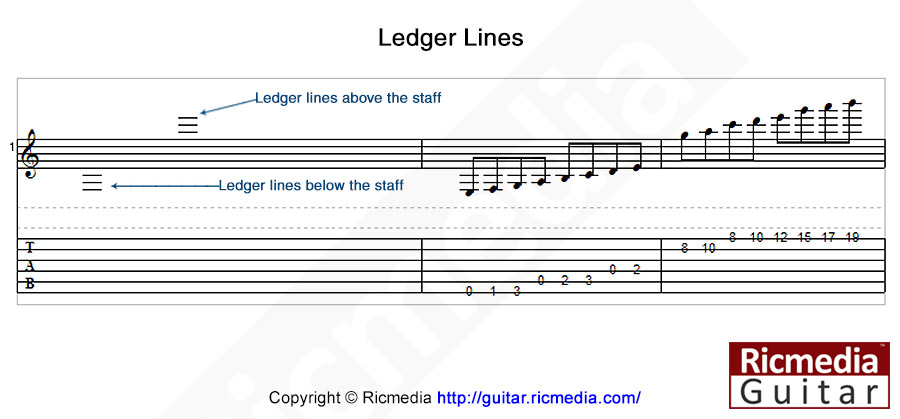Today we will learn all about the staff or stave, clefs and ledger lines we use in music theory. If you have never studied music theory before, this is a great place to start.
Contents
Staff
A staff (US), or stave (UK), is the scaffolding on which composers write music. Consisting of five lines and four spaces, a staff can be in two different tonal boundaries depending on the clef that is used (treble clef or bass clef) and each line and space represents a specific pitch (respective to the clef used). A staff is also used for percussion with each line representing a different instrument.
Standard staff
Below is an example of a standard staff void of any clef.
Staff with TAB
Our next example is a standard staff with guitar tablature or TAB section which is a visual representation of the guitar neck where numbers placed on the lines signify fret numbers. In TAB the top line is the first string (thinnest) and the bottom is the sixth string (thickest).
Grand staff
Next is a Grand staff which is two staffs on top of each other, held together by a brace on the far left. A Grand staff has a treble clef on the top section, and a bass clef on the bottom section (see next part of this lesson) which enables composers to write music for instruments with a wide tonal range like the piano or harp.
Treble clef & bass clef
A clef is a musical symbol that defines the tonal range of the staff they are written on.
Treble clef
On the example below we have a staff with a treble clef written on the far left hand side, this indicates that any notes written on this staff should be played in the treble tonal range which is the first G above middle C. Instruments in this category include the guitar.
Bass clef
The next example below shows a staff with a bass clef written on the far left hand side, this indicates that any notes written on this staff should be played in the bass tonal range which is the first F below middle C. Instruments in this category include the bass guitar.
Grand staff
Onto our last example below which is a Grand staff written with both a treble clef on the top staff and bass clef on the bottom staff. Grand staffs are used for instruments with a very wide tonal range like the piano or harp. Middle C is found on the one (and only) ledger line in between the two staffs (see image below).
Ledger line
Onto the last section of this lesson about the ledger line. A ledger line is simply an extension of the staff written either below or above it, and is used when the tonal range exceeds the staff itself. In music written for the guitar, it is frequently necessary to use ledger lines as the tonal range exceeds six lines above a standard treble clef, this can be very hard to read so often a composer will simply use an 8va symbol to signify that the section should be played one octave higher than written.
Summary
If this is your first foray into music theory then I really hope you liked this lesson. Be sure to follow on to the next theory lesson: Measures & bars.
Cheers & enjoy!







Leave a Reply